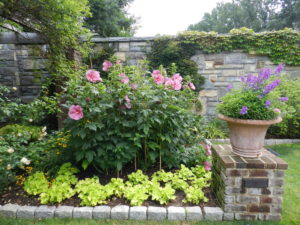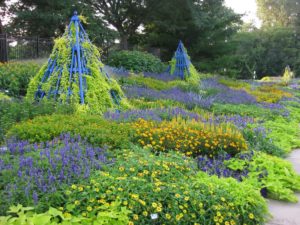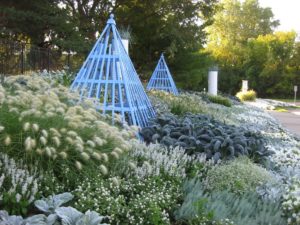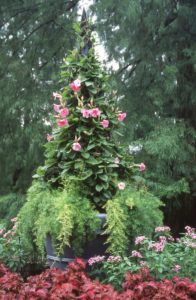Where do you look when you enter a garden? Straight ahead, at eye level? Down at the ground to see where you are going? Up at tree canopies? The first and second yes, the last – not very often.

Poor layering – only short and tall, no middle layer between Hibiscus and Heuchera

Excellent layering – Staggered heights in long bed at Jardin du Luxembourg in Paris
On the other hand, if there are attractive arbors or obelisks that demand our attention, we tend to look up. One of the elements of composition is layering. This doesn’t mean a row of short plants, a row of medium plants, and a row of tall plants. That would be boring. The heights should be mingled to keep the eye moving.

Blue obelisks in blue-chartreuse garden

Blue obelisk in gray-white garden
Inserting an obelisk is a different way of adding height to a bed. At the Rotary Botanical Gardens, in Janesville, Wisconsin, a series of painted wooden obelisks is used to add both color and height to their annuals gardens. The obelisks are repainted each year to foster the color themes chosen for that year. For instance, one year, the obelisks were bright blue. The plantings were blue and yellow and chartreuse vines were encouraged to partially obscure the obelisks. In another bed, the bright blue obelisks were free of vines but provided subtle color echo for the gray and white plantings. I love the interplay of textures, especially that of Lacinato kale and the ornamental grass, probably Pennisetum villosum.

Painted obelisk with Lychnis coronaria and roses
When I visited the National Arboretum garden in the middle of Washington, I noted how important the bright pink obelisks were to an otherwise lackluster garden. Yes, there was bright pink Lychnis coronaria and white roses against a background of conifers but the obelisks were the crucial element in that composition. Without them, my eye would probably have stopped at the top of the conifers but the fact that the obelisks were a bit taller made me look up to the tall trees behind them.

Obelisk in Dutch garden
Subtle obelisks also make you look up. A metal obelisk with a blue gazing ball on top echoed the color of the lacecap hydrangea to its left and the verticality of the Veronicastrum in front of it. More importantly, however, it made me look higher to the tall shrubs behind it.

Container with obelisk for Mandevilla at Longwood Gardens
Keep in mind that obelisks, because of their height, become focal points. You will, therefore, want them to be in good shape and to be attractive. They can also be used in containers to add height or support. Sometimes, the plant you grow on the obelisk can be so vigorous that it totally obscures the obelisk. However, if you leave the container in place during the winter, the obelisk becomes the focal point for the dormant months.
Where could you place an obelisk to add interest and height to your landscape?


0 Comments